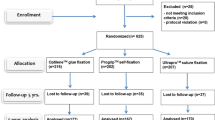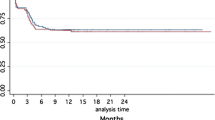Abstract
Purpose
To compare the results of conventional Lichtenstein hernioplasty with polypropylene mesh (PLP) with a lightweight self-adhesive mesh (Parietene Progrip®; Covidien, Dublin, Ireland) (PPG) used in patients with bilateral inguinal hernia.
Methods
Randomised clinical trial with 89 patients with a minimum follow-up of 1 year. Every patient had bilateral inguinal hernia and had both prostheses implanted randomly, one on each side. Early postoperative and chronic pain was evaluated using the visual analogue scale. Also recurrence rate and subjective evaluation of patients were analysed.
Results
Pain in the early postoperative period was inferior on the side where the self-adhesive mesh had been implanted (6.12 vs. 6.62, p=0.005 during the 1st postoperative day; 2.12 vs. 2.62, p=0.001 during the 7th postoperative day). Differences disappeared with the long-term evaluation (0.71 vs. 0.98, p=0.148 1 year after the surgery). The operative time was significantly shorter on the PPG mesh side (24.37±5.1 in case of the PPG mesh and 29.66±5.6 in case of the PLP mesh, p<0,001). Recurrence occurred in seven patients (7.8%), six of them (6.7%, CI 3.0–14.4) on the PPG mesh side and one (1.1%, CI 0.2–7.8) on the PLP side. These differences were not statistically significant (p=0.125)
Conclusions
Although hernioplasty with self-adhesive mesh reduced early postoperative pain, this reduction was clinically irrelevant and it had no influence on chronic pain. There was a trend towards a higher recurrence rate when self-adhesive meshes were used, and although in this study differences were not statistically significant they should be confirmed in later studies using larger samples. Surgical procedures that do not need fixing sutures are promising, but further studies are needed before they become the gold standard of inguinal hernia repair.

Similar content being viewed by others
References
Kingsnorth A, Leblanc K (2003) Hernias: inguinal and incisional. Lancet 362:1561–1571
EU Hernia Trialists Collaboration (2000) Mesh compared with non-mesh methods of open groin hernia repair: systematic review of randomized controlled trials. Br J Surg 87:854–859
VanVeen RN, Wijsmuller AR, Vrijland WW, Hop WC, Lange JF, Jeekel J (2007) Long-term follow-up of a randomized clinical trial of non-mesh versus mesh repair of primary inguinal hernia. Br J Surg 94:506–510
Mokete M, Earnshaw JJ (2001) Evolution of an inguinal hernia surgery practice. Postgrad Med 77:188–190
Willaert W, De Bacquer D, Rogiers X, Troisi R, Berrevoet F (2012) Open preperitoneal techniques versus Lichtenstein repair for elective inguinal hernias. Cochrane Database Syst 7:CD008034
Massaron S, Bona S, Fumagalli U, Battafarano F, Elmore U, Rosati R (2007) Analysis of post-surgical pain after inguinal hernia repair: a prospective study of 1,440 operations. Hernia 11:517–525
Nienhuijs S, Staal E, Strobbe L, Rosman C, Groenewoud H, Bleichrodt R (2007) Chronic pain after mesh repair of inguinal hernia: a systematic review. Am J Surg 194:394–400
Kehlet H (2008) Chronic pain after groin hernia repair. Br J Surg 95:135–136
Bay-Nielsen M, Perkins FM, Kehlet H (2001) Pain and functional impairment 1 year alter inguinal herniorrhaphy: a nationwide questionnaire. Ann Surg 233:1–7
Alfieri S, Amid PK, Campanelli G, Izard G, Kehlet H, Wijsmuller AR, Di Miceli D, Doglietto GB (2011) International guidelines for prevention and management of post-operative chronic pain following inguinal hernia surgery. Hernia 15:239–249
Bringman S, Wollert S, Osterberg J, Smedberg S, Granlund H, Heikkinen TJ (2006) Three-year results of a randomized clinical trial of lightweight or standard polypropylene mesh in Lichtenstein repair of primary inguinal hernia. Br J Surg 93:1056–1059
O’Dwyer PJ, Kingsnorth AN, Molloy RG, Small PK, Lammers B, Horeyseck G (2005) Randomized clinical trial assessing impact of a lightweight or heavyweight mesh on chronic pain after inguinal hernia repair. Br J Surg 92:166–170
Post S, Weiss B, Willer M, Neufang T, Lorenz D (2004) Randomized clinical trial of lightweight composite mesh for Lichtenstein inguinal hernia repair. Br J Surg 91:44–48
Köninger J, Redecke J, Butters M (2004) Chronic pain after hernia repair: a randomized trial comparing Shouldice, Lichtenstein and TAPP. Langenbecks Arch Surg 389:361–365
Polish Hernia Study Group, Śmietański M (2008) Randomized clinical trial comparing a polypropylene with a poliglecaprone and polypropylene composite mesh for inguinal hernioplasty. Br J Surg 95:1462–1468
Klinge U, Klosterhalfen B, Muller M, Schumpelick V (1999) Foreign body reaction to meshes used for the repair of abdominal wall hernias. Eur J Surg 165:665–673
Champault G, Polliand C, Dufour F, Ziol M, Behr L (2009) A “self adhering” prosthesis for hernia repair: experimental study. Hernia 13:49–52
Crea N, Pata G (2010) Effects of prophylactic ilioinguinal nerve excision in mesh groin hernia repair: short-and long-term follow-up of a randomized clinical trial. Am Surg 76:1275–1281
Smeds S, Lofstrom L, Eriksson O (2010) Influence of nerve identification and the resection of nerves “at risk” on postoperative pain in open inguinal hernia repair. Hernia 14:265–270
Alfieri S, Rotondi F, di Giorgio A, Fumagalli U, Salzano A, Di Micoli D, Ridolfini MP, Sgagari A, Doglietto G (2006) Influence of preservation versus division of ilioinguinal, iliohypogastric and genital nerves during open mesh herniorrhaphy: prospective, multicentric study of chronic pain. Ann Surg 243:553–558
Amid PK (2004) Lichtenstein tension-free hernioplasty: its inception, evolution, and principles. Hernia 8:1–7
Stremitzer S, Bachleitner-Hofmann T, Gradl B, Gruenbeck M, Bachleitner-Hofmann B, Mittlboeck M, Bergmann M (2010) Mesh graft infection following abdominal hernia repair: risk factor evaluation and strategies of mesh graft preservation. A retrospective analysis of 476 operations. World J Surg 34:1702–1709
Kingsnorth A, Nienhuijs S, Schule S, Appel P, Ziprin P, Eklund A et al (2010) Preliminary results of a comparative randomized study-benefit of self-gripping Parietex ProGrip mesh in open inguinal hernia repair. Hernia 14(suppl 1):S1
Kingsnorth A, Gingell-Littlejohn M, Nienhuijs S, Schüle S, Appel P, Ziprin P, Eklund A, Miserez M, Smeds S (2012) Randomized controlled multicenter International clinical trial of self-gripping Parietex ™ Progrip™ polyester mesh versus lightweight polypropylene mesh in open inguinal hernia repair: interim results at 3 months. Hernia 16:287–294
Kapischke M, Schulze H, Caliebe A (2010) Self-fixating mesh for the Lichtenstein procedure—a prestudy. Langenbecks Arch Surg 395:317–322
Jorgensen LN, Sommer T, Assaadzadeh S, Strad L, Dorfelt A, Hensler M, Rosenberg J, Danish Multicentre DANGRIP Study Group (2013) Randomized clinical trial of self-gripping mesh versus sutured mesh for Lichtenstein hernia repair. Br J Surg 100:474–478
Negro P, Basile F, Brescia A, Buonanno GM, Campanelli G, Canonico S et al (2011) Open tension-free Lichtenstein repair of inguinal hernia: use of fibrin blue versus sutures for mesh fixation. Hernia 15:7–14
Paajanen H (2002) Do absorbable mesh sutures cause less chronic pain than nonabsorbable sutures after Lichtenstein inguinal herniorrhaphy? Hernia 6:26–28
Kim-Fuchs C, Angst E, Vorburger S, Helbling C, Candinas D, Schlumpf R (2012) Prospective randomized trial comparing sutured with sutureless mesh fixation for Lichtenstein hernia repair: long-term results. Hernia 16:21–27
Chastan P (2009) Tension free open hernia repair using an innovative self-gripping semi-resorbable mesh. Hernia 13:137–142
Conflict of interest
JP declares no conflict of interest. MC declares no conflict of interest. AP declares no conflict of interest. MA declares no conflict of interest. OC declares no conflict of interest. EQ declares no conflict of interest. SV declares no conflict of interest. BR declares no conflict of interest. CS declares no conflict of interest. OB declares no conflict of interest. AM declares no conflict of interest. BP declares no conflict of interest.
Author information
Authors and Affiliations
Corresponding author
Rights and permissions
About this article
Cite this article
Porrero, J.L., Castillo, M.J., Pérez-Zapata, A. et al. Randomised clinical trial: conventional Lichtenstein vs. hernioplasty with self-adhesive mesh in bilateral inguinal hernia surgery. Hernia 19, 765–770 (2015). https://doi.org/10.1007/s10029-014-1316-7
Received:
Accepted:
Published:
Issue Date:
DOI: https://doi.org/10.1007/s10029-014-1316-7




